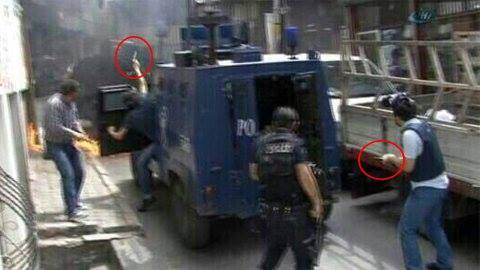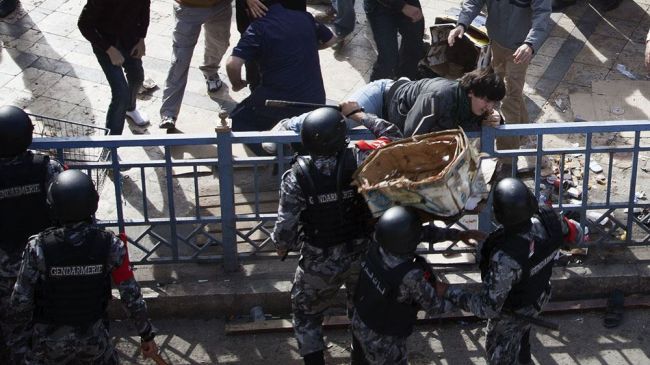ΚΕΙΜΕΝΟ ΤΩΝ 5 ΕΚΖΗΤΟΥΜΕΝΩΝ ΑΠΟ ΤΙΣ ΙΤΑΛΙΚΕΣ ΑΡΧΕΣ
1.
Την 1η Μαη 2015 μια μεγαλειώδης διαδήλωση λαμβάνει χώρα στα πλαίσια της Εργατικής Πρωτομαγιάς στο Μιλάνο. Δεν ήταν απλά μια μέρα γενικής απεργίας, αλλά μια μέρα Πανιταλικής συνάντησης των κινημάτων (σωματεία βάσης, κοινωνικά κέντρα, φοιτητικές και μαθητικές ομάδες, επιτροπές αγώνα για τη στέγη, μεταναστευτικές κοινότητες, το κίνημα No Tav κλπ) ενάντια στα μέτρα λιτότητας που περνούσε το τελευταίο διάστημα η κυβέρνηση Ρέντσι. ‘Hταν επίσης και το αποκορύφωμα ολόκληρου του κινήματος ΝO EXPO ενάντια στην παγκόσμια επιχειρηματική έκθεση EXPO 2015 με συμμετοχή κόσμου από πολλές χώρες της Ευρώπης και τα προκλητικά χλιδάτα εγκαίνιά της, την ημέρα εκείνη. Η μαζικότητα και η δυναμική της διαδήλωσης ήταν το αποκορύφωμα ενός κινήματος επτά χρόνων που έθεσε σε αμφισβήτηση την έκθεση και την πολιτική εκστρατεία γύρω από αυτήν, φέρνοντας σε κρίση τις πολιτικές καριέρες των κυβερνητικών αξιωματούχων και τοπικών “αρχόντων”.
Επτά χρόνια πριν, το 2008, ο δήμος του Μιλάνου αναλαμβάνει να φιλοξενήσει την έκθεση. Για χάρην αυτής, τσιμεντοποιούνται 1100 στρέμματα γης, αποφασίζεται ο εκτοπισμός ντόπιων με σκοπό την αρπαγή των κατοικιών και της γης τους, ώστε να υποταχθούν στα αναπτυξιακά σχέδια αλλά και στην ισοπεδωτική εμπορευματοποίησή τους. Τα αφεντικά βάζουν στοίχημα το Μιλάνο να γίνει η πιο ελκυστική για τα κεφάλαια πόλη, προσπαθούν να την αναδείξουν σαν επιχειρηματική πρωτεύουσα και να την προμοτάρουν σαν το 8ο θαύμα για την ντόπια εργατική τάξη, στην οποία υπόσχονται ανάπτυξη και νέες θέσεις εργασίας. Μια ολόκληρη πόλη στιλιζάρεται από πολυτελή κτίρια, νέους αυτοκινητόδρομους και φαντασμαγορικά έργα. Πίσω από τις αναπτυξιακές βιτρίνες οι μίζες πέφτουν σαν ντόμινο η μια μετά την άλλη, οι τράπεζες δανείζουν, διαχειρίζονται και ξεπλένουν χρήμα για τους υπολοίπους, οι εργολάβοι φροντίζουν να καθυστερούν τα έργα για να έρθουν υπερτιμολογήσεις και φυσικά, ανάμεσα στους υπερεργολάβους εμπλέκονται και μαφιόζοι με τις εταιρείες τους.
Αυτός ο κύκλος κερδοφορίας των αφεντικών που ξεκίνησε το 2008 στήθηκε και ολοκληρώθηκε πάνω στη στυγνή εκμετάλλευση κακοπληρωμένης αλλά και εθελοντικής εργασίας χιλιάδων νέων, εξοικονομώντας ακόμα περισσότερες χιλιάδες ευρώ για τις τσέπες των αφεντικών. Παράλληλα με την οικοδόμηση της έκθεσης, πραγματοποιείται μια επιχείρηση εκκαθάρισης των όσων μπορούσαν να θεωρηθούν επικίνδυνοι για τη μακιγιαρισμένη εικόνα της πόλης. Μεγάλες αστυνομικές επιχειρήσεις πραγματοποιούνται στις γειτονιές με εξώσεις εργατικών κατοικιών ντόπιων και μεταναστών, εκκενώσεις κοινωνικών κέντρων και επιστράτευση απεργιών με αποκορύφωμα την απεργία των εργαζομένων στο μετρό λίγες μέρες πριν τα εγκαίνια.
2.
Και ενώ 6 μήνες μετά πέφτει η αυλαία της έκθεσης, τα αποτελέσματα και οι συνέπειες μένουν. Η EXPO κλείνει και αφήνει πίσω της 1,5 δις έλλειμμα που θα πληρωθεί μέσω των αυξημένων δημοτικών τελών και φόρων, αναγκάζοντας τους προλετάριους κάτω από τη «συλλογική ευθύνη» των χρεών να πληρώσουν τα σπασμένα και να πουν κι ευχαριστώ γι’ αυτή τη φαντασμαγορική γιορτή. Αφήνει πίσω της λεηλατημένη γη, ελαστικοποίηση των εργασιακών σχέσεων, εγκαθίδρυση του εθελοντισμού, καταστολή. Μετά από 6 μήνες λοιπόν, από την προσαγωγή μας στο Μιλάνο, και στην αυλαία της διεθνούς έκθεσης, οι ιταλικές αρχές ξεκινάνε ένα κυνήγι μαγισσών κατασκευάζοντας κατηγορητήρια, και εκδίδουν ένταλμα σύλληψης για 5 Ιταλούς διαδηλωτές, ενώ παράλληλα εκδίδεται και Ευρωπαϊκό Ένταλμα Σύλληψης για εμάς τους 5. Έχουμε κάθε λόγο να πιστεύουμε πως οι εκ των υστέρων διώξεις μας καθώς και των 5 ιταλών διαδηλωτών κρύβουν πολιτική σκοπιμότητα, και αυτό όχι μόνο γιατί ποινικοποιούν την ίδια τη συμμετοχή σε μια διαδήλωση βάση ενός φασιστικού νόμου που θεσπίστηκε επί Μουσολίνι και ισχύει μέχρι και σήμερα, αλλά και γιατί οι Ιταλικές αρχές ξεκινάνε μια επιχείρηση συγκάλυψης και αποσιωποίησης της “καμένης” γης που άφησε πίσω της η EXPO, στρέφοντας την προσοχή της κοινής γνώμης από τα σκάνδαλα στους διαδηλωτές, ώστε να σώσουν, να χτίσουν και να εξαργυρώσουν τις πολιτικές τους καριέρες. Η δίωξη μας αποτελεί για τις ιταλικές αρχές την ιδανική ευκαιρία για να τιμωρήσει και να παραδειγματίσει εμάς και όσες/όσους βρέθηκαν εκείνες τις μέρες στους δρόμους. Είναι η ιδανική ευκαιρία για να δείξει τι μέλλον επιφυλάσσεται στον καθένα και στην καθεμία που επιλέγει να αγωνιστεί και να συναντηθεί με άλλα κινήματα σε εθνικό και ευρωπαϊκό επίπεδο.
Η έκδοση του Ευρωεντάλματος, τα γελοία κατηγορητήρια, η ποινικοποίηση της συμμετοχής σε διαδηλώσεις, οι πολιτικές δίκες που κατά καιρούς έχουν οδηγήσει στις φυλακές αγωνιστές για 15 χρόνια, στέλνουν ένα ξεκάθαρο μήνυμα πως όσο οι από τα κάτω συνεβρίσκονται στους δρόμους και ενώνουν τις φωνές τους, η καταστολή θα μένει και θα εντείνεται.
3.
Το Ευρωπαϊκό Ένταλμα Σύλληψης ενεργοποιείται για πρώτη φορά (μέχρι τώρα έχει χρησιμοποιηθεί μόνο για βαριά ποινικά αδικήματα όπως εμπορία ναρκωτικών, σωματεμπορία, ξέπλυμα μαύρου χρήματος κλπ) για να διώξει διαδηλωτές. Αποτελεί ξεκάθαρα μια προσπάθεια αναβάθμισης της διεθνοποιημένης καταστολής και μια απόπειρα ποινικοποίησης των κοινωνικών αγώνων και της συνάντησης των κινημάτων σε πανευρωπαϊκό επίπεδο. Ταυτόχρονα αποτελεί ένα στοίχημα όλων των κομματιών του ευρωπαϊκού – ανταγωνιστικού κινήματος να μπεί ένα φρένο σε αυτές τις κατασταλτικές μεθοδεύσεις μπλοκάροντας στην πράξη τις εκδόσεις.
Την περίοδο 2008-2010, με το ξέσπασμα της ύφεσης λόγω της παγκόσμιας καπιταλιστικής κρίσης στις ευρωπαϊκές οικονομίες, τα κράτη-μέλη της ΕΕ για να σώσουν το (διεθνές) χρηματοπιστωτικό σύστημα έτρεξαν να πάρουν μέτρα για να κρατικοποιήσουν την μεγάλη χασούρα του. Πρώτο το ελληνικό κράτος και έπειτα και άλλα κράτη της Ευρωζώνης. Βέβαια, αυτό από μόνο του δεν θα έλυνε τίποτα, επειδή η «κρίση του χρηματοπιστωτισμού» δεν εκφράζει παρά μια κρίση της παραγωγής κι αναπαραγωγής του κεφαλαίου. Οπότε το πρόβλημα έπρεπε να χτυπηθεί στη ρίζα του: η υποτίμηση της εργατικής δύναμης και το σακάτεμα της ζωής των προλετάριων, με σκοπό το ξεπέρασμα της κρίσης με πιο ευνοϊκούς όρους κερδοφορίας για το κεφάλαιο.
Έτσι, οι ντόπιοι και διεθνείς καπιταλιστές και οι κυβερνήσεις τους, ξεκίνησαν να εφαρμόζουν μέτρα λιτότητας ή να μπαίνουν σε αυστηρά προγράμματα δομικής προσαρμογής. Μέτρα, που είναι γνωστά σε εμάς εδώ ως «μνημόνια» και που συνεχίζει να ψηφίζει και να εφαρμόζει η συγκυβέρνηση ΣΥΡΙΖΑ-ΑΝΕΛ, όπως οι περικοπές των μισθών, συντάξεων κι επιδομάτων, οι μειώσεις των δημοσίων δαπανών, η αύξηση της φορολογίας σε τρόφιμα κι είδη πρώτης ανάγκης, οι ιδιωτικοποιήσεις κι η απελευθέρωση των απολύσεων, η αύξηση των ορίων ηλικίας συνταξιοδότησης κλπ.
4.
Όλα αυτά θα μπορούσαν να επιβληθούν μόνο μέσα από μια μόνιμη «κατάσταση έκτακτης ανάγκης», που εκτός από την πολιτική του «δημόσιου χρέους» ως μοχλό επιβολής και τρομοκρατίας έρχεται και μέσα από την απόσυρση του «κράτους πρόνοιας» και την αντικατάστασή του με ένα «κράτος ασφάλειας». Πτυχές της ίδιας στρατηγικής διαχείρισης της κρίσης από το κεφάλαιο για την επιβολή νέων κανόνων πειθάρχησης και εκμετάλλευσης των «από τα κάτω».
Ένα γενικευμένο «καθεστώς έκτακτης ανάγκης» επιβάλλεται βήμα βήμα σε όλη την Ευρώπη με αφορμή την απειλή της «ισλαμικής τρομοκρατίας», με μια ευρεία στρατικοποίηση των δυτικών μητροπόλεων. Μια μεγάλη σε κλίμακα εκστρατεία φόβου και απόλυτου ελέγχου που ξεκινάει από εφόδους σε σπίτια ακτιβιστών, απαγόρευση διαδηλώσεων, θέσπιση νέων αντιτρομοκρατικών νόμων και καταλήγει σε περιπολίες στρατών στους δρόμους. Κι είναι γνωστό ότι όλο αυτό το πολεμικό περιβάλλον δεν στρέφεται μόνο ενάντια στους μετανάστες/στριες που καταφέρνουν και καταφθάνουν στην Ευρώπη από τις εμπόλεμες ζώνες της Αφρικής και της Ασίας, αλλά και σε όλους εκείνους που επιλέγουν σήμερα και αύριο να βγουν στους δρόμους και να διαδηλώσουν κόντρα στις πολιτικές λιτότητας και υποτίμησης, στην Ευρώπη-φρούριο, στη σιγή νεκροταφείου που πάει να επιβληθεί και να γίνει ο κανόνας.
5.
Στις 7,8 και 11 Ιανουαρίου καλούμαστε να δώσουμε τη μάχη ενάντια στις εκδόσεις αυτές. Ο αγώνας για το μπλοκάρισμά τους, αποτελεί κομμάτι ενός ευρύτερου ψηφιδωτού αγώνων που στέκονται ανάχωμα στην συνεχιζόμενη υποτίμηση των ζωών μας. Αποτελεί κομμάτι εκείνων των αγώνων των φοιτητών/φοιτητριών ενάντια στην αύξηση του κόστους φοίτησης στα πανεπιστήμια, των καθημερινών εργατικών κοντρών με τα αφεντικά και τις απεργιακές περιφρουρήσεις στους χώρους δουλειάς, των κινήσεων άρνησης πληρωμών πάνω στις βασικές ανάγκες από συνελεύσεις γειτονιών, των διεκδικήσεων των επισφαλών-πρεκάριων ενάντια στα σύγχρονα σκλαβοπάζαρα-“κοινωφελή προγράμματα”, των εξεγέρσεων μεταναστών/στριων στα σύνορα και τα κέντρα κράτησης της χώρας και κάθε κοινότητας αγώνα που ξεπηδά στη δημόσια σφαίρα κόντρα στις καπιταλιστικές προσταγές και την κρατική καταστολή.
Καλούμε όλους τους συναδέλφους, τους συμφοιτητές, τους συντρόφους και όλο τον κόσμο του αγώνα να κάνουν δική τους την υπόθεση των διώξεων, να πάρουν θέσεις μάχης, να μπλοκάρουν τις εκδόσεις στην πράξη.
“Ένα χτύπημα σε έναν από μας, είναι χτύπημα σε όλους μας”
OΛΟΙ ΚΑΙ ΟΛΕΣ ΣΤΟ ΕΦΕΤΕΙΟ 7, 8 ΚΑΙ 11 ΙΑΝΟΥΑΡΙΟΥ
Οι 5 εκζητούμενοι από τις Ιταλικές αρχές
2/1/2016










